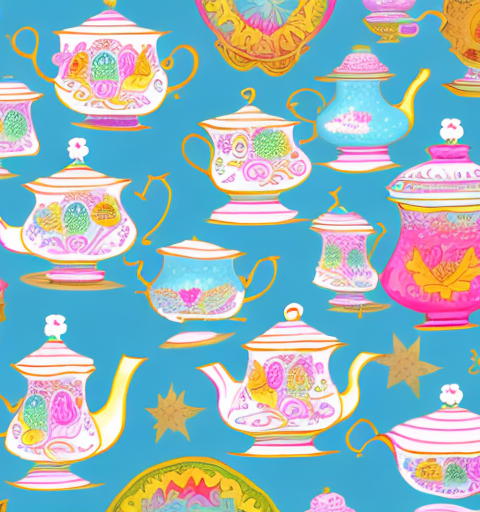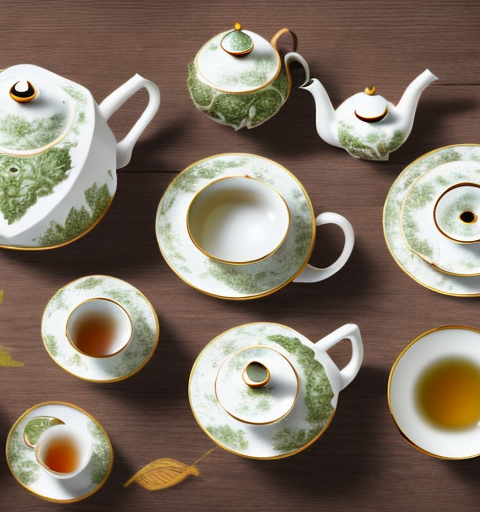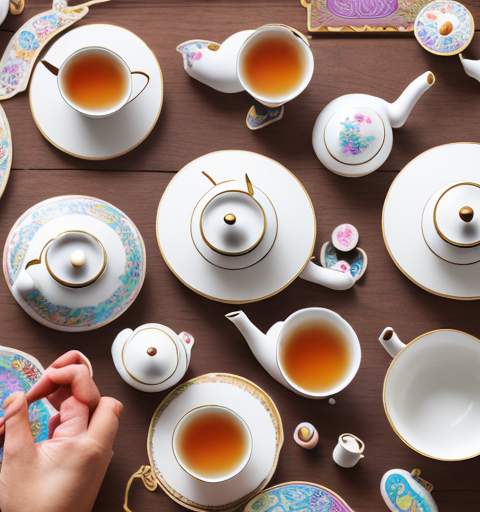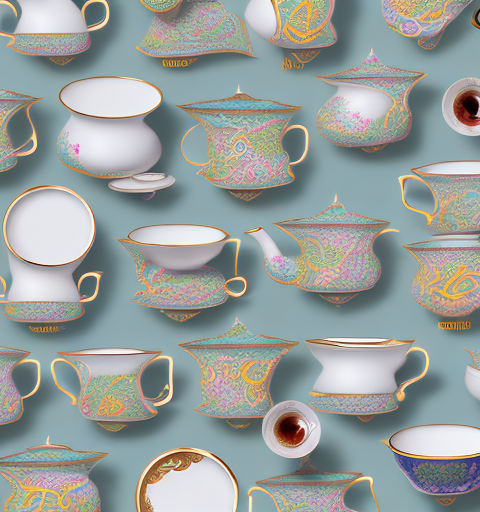If you have ever been captivated by the elegance and charm of antique teapots, then you are not alone. These exquisite vessels, steeped in history and adorned with intricate designs, have become highly sought-after collector’s items. In this comprehensive guide, we will explore the fascinating world of antique teapots, from their rich cultural significance to practical tips on starting and maintaining your own collection. So grab a cup of tea and join us on this delightful journey into the enchanting realm of antique teapots.
Understanding the World of Antique Teapots
The History of Teapots
Before we delve into the colorful world of antique teapots, it is essential to understand their fascinating history. Tea has been enjoyed for centuries, and as its popularity grew, so too did the demand for teapots. From the simple clay vessels crafted in ancient China to the intricate porcelain creations of European artisans, teapots have evolved both in form and function.
Let’s start our journey in ancient China, where the story of teapots begins. Tea was first discovered in China during the Shang Dynasty, around 1500 BCE. Initially, tea was consumed in powdered form and whisked with hot water. However, as tea drinking became more popular, the need for a vessel specifically designed for steeping and serving tea arose. This led to the creation of the first teapots, which were made of clay and had a simple, utilitarian shape.
As tea spread to other parts of the world, different cultures put their own spin on the design of teapots. In Europe, for example, teapots became a symbol of status and wealth during the 17th and 18th centuries. Elaborate porcelain teapots adorned with intricate floral patterns were highly sought after by the European elite.
Meanwhile, in Japan, teapots took on a more minimalist and Zen-inspired aesthetic. The famous Yixing clay teapots from China also gained popularity during this time. These teapots were known for their natural clay colors and unglazed surfaces, which were believed to enhance the flavor of the tea.
As we delve deeper into the subject of collecting antique teapots, we will uncover the stories behind these treasured pieces and the cultures that inspired their creation. Each teapot has a unique tale to tell, and by exploring their history, we can gain a deeper appreciation for these exquisite objects.
Different Types of Antique Teapots
One of the joys of delving into the world of antique teapot collecting is discovering the incredible diversity of styles and designs. From delicate porcelain teapots adorned with delicate floral motifs to sturdy cast iron creations, there is a teapot to suit every taste.
Let’s start by exploring the elegance of English bone china teapots. These teapots are known for their delicate and translucent appearance, which is achieved by adding bone ash to the clay. They often feature intricate hand-painted designs, ranging from floral patterns to scenic landscapes. English bone china teapots are highly sought after by collectors for their timeless beauty and craftsmanship.
If you prefer a more rustic and earthy aesthetic, Yixing clay teapots from China might be the perfect choice for you. These teapots are made from a unique type of clay found only in the Yixing region of China. They are known for their unglazed surfaces, which absorb the flavors of the tea over time, enhancing the taste with each brew. Yixing teapots are often adorned with simple yet elegant designs, reflecting the Zen philosophy of simplicity and harmony.
For those who appreciate bold and distinctive designs, cast iron teapots are a wonderful option. These teapots originated in Japan and were initially used in traditional tea ceremonies. They are known for their durability and heat retention properties, making them ideal for brewing and serving tea. Cast iron teapots often feature intricate patterns and motifs, such as cherry blossoms or dragons, adding a touch of elegance to any tea-drinking experience.
Whether you prefer the elegance of English bone china or the rustic beauty of Yixing clay, there is sure to be a teapot that calls to you. Exploring the different types of antique teapots is like embarking on a journey through time and culture, each teapot offering a glimpse into a different era and artistic tradition.
The Cultural Significance of Teapots
Beyond their aesthetic appeal, antique teapots hold immense cultural significance. They are not merely functional objects but reflect the social customs and artistic traditions of their respective eras. The designs, materials, and craftsmanship of teapots often reveal fascinating insights into the cultures that created them.
Let’s start by exploring the cultural significance of Chinese porcelain teapots. Chinese porcelain has a long and storied history, with each piece carrying its own symbolism and meaning. For example, blue and white porcelain teapots were highly prized during the Ming Dynasty, symbolizing purity and elegance. The intricate patterns and motifs on these teapots often told stories or conveyed wishes for good fortune and prosperity.
In Europe, teapots became more than just vessels for brewing and serving tea. They became a symbol of refinement and sophistication, particularly during the Rococo period. Rococo-inspired teapots were adorned with elaborate decorations, such as ornate handles and spouts, intricate scrollwork, and even miniature sculptures. These teapots were often displayed as works of art, showcasing the wealth and taste of their owners.
Antique teapots from different cultures also reflect the influence of trade and cultural exchange. For example, during the 18th century, Chinese porcelain teapots were highly sought after in Europe, leading to the development of European porcelain factories that imitated the Chinese style. These European-made teapots often incorporated elements of both Chinese and European design, creating a unique fusion of artistic traditions.
Understanding the cultural context can deepen your appreciation for these exquisite collectibles and enable you to convey their stories to others. Each teapot is a testament to the creativity and craftsmanship of its time, offering a glimpse into the rich tapestry of human history and cultural diversity.
Starting Your Antique Teapot Collection
Welcome to the fascinating world of antique teapot collecting! If you’re reading this, it means you’re ready to embark on a thrilling journey filled with history, beauty, and the joy of uncovering hidden treasures. In this guide, we will provide you with valuable information on where to find antique teapots, how to choose the right ones for your collection, and how to budget wisely for your newfound passion.
Where to Find Antique Teapots
Now that we have ignited your passion for antique teapots, it’s time to embark on the thrilling hunt for your perfect piece. Antique shops, flea markets, and online auctions are just a few of the many places where you can discover hidden gems waiting to be uncovered. Each location offers its own unique charm and opportunities for finding rare teapots.
Antique shops are a treasure trove of history, often filled with teapots that have stories to tell. Exploring these shops allows you to physically examine each teapot, feel its weight, and appreciate the intricate details up close. The thrill of stumbling upon a teapot with a rich history and a unique design is an experience like no other.
Flea markets, on the other hand, offer a more casual and eclectic atmosphere. Here, you can wander through rows of stalls, talking to vendors, and stumbling upon unexpected teapots that capture your heart. The charm of a flea market lies in the element of surprise, as you never know what rare teapot might be waiting for you amidst a sea of vintage treasures.
If you prefer the convenience of online shopping, online auctions and marketplaces provide a vast selection of antique teapots from all over the world. With just a few clicks, you can explore teapots from different eras and cultures, compare prices, and read reviews from other collectors. The online world opens up a realm of possibilities and allows you to connect with fellow enthusiasts from around the globe.
How to Choose the Right Teapot for Your Collection
As you begin building your collection, it’s important to consider your personal preferences and the specific characteristics that make each teapot unique. Do you prefer delicate elegance or bold, eye-catching designs? Are you drawn to a particular era or culture? Taking the time to reflect on these questions will help you curate a collection that truly resonates with your aesthetic preferences and collection goals.
One approach to selecting teapots is to focus on a specific era or style. For example, if you are captivated by the elegance of the Victorian era, you can seek out teapots adorned with intricate floral patterns and delicate handles. On the other hand, if you have a penchant for bold and abstract designs, exploring teapots from the Art Deco period might be more to your liking.
Another factor to consider is the material of the teapot. Antique teapots can be made from a variety of materials, including porcelain, silver, and even glass. Each material has its own unique qualities and aesthetic appeal. For instance, a porcelain teapot exudes elegance and refinement, while a silver teapot adds a touch of luxury and sophistication to your collection.
Ultimately, the right teapot for your collection is the one that speaks to you on a personal level. It might be love at first sight, or it might take time to develop a connection with a particular teapot. Trust your instincts and let your passion guide you in selecting teapots that will bring you joy and pride as you continue to expand your collection.
Budgeting for Your Collection
Collecting antique teapots can become an absorbing passion, but it’s crucial to establish a budget that suits your financial situation. Setting a limit for each acquisition will help you make thoughtful decisions and prevent overspending. It’s important to strike a balance between indulging in your love for antique teapots and maintaining financial stability.
One approach to budgeting is to allocate a specific amount of money each month for your teapot collection. This allows you to enjoy the thrill of acquiring new pieces while staying within your financial means. Additionally, researching and comparing prices before making a purchase can help you find the best deals and ensure that you are getting the most value for your money.
Another budgeting strategy is to focus on quality over quantity. Instead of acquiring numerous inexpensive teapots, consider investing in a few high-quality pieces that truly captivate you. Remember, it’s not about the number of teapots in your collection, but rather the joy and significance each one brings to your life.
Lastly, don’t forget to factor in additional costs such as restoration and maintenance. Antique teapots may require occasional repairs or professional cleaning to preserve their beauty and functionality. Including these costs in your budget will ensure that your collection remains in excellent condition for years to come.
With these insights and tips, you are now equipped to begin your journey into the enchanting world of antique teapot collecting. Happy hunting and may your collection grow with each new teapot that finds its way into your hands!
Evaluating and Buying Antique Teapots
Welcome to the fascinating world of antique teapots! As you embark on your journey to explore and acquire these timeless treasures, it is essential to equip yourself with the knowledge and skills necessary to make informed purchasing decisions. In this guide, we will delve into the intricacies of evaluating and buying antique teapots, covering various aspects that will help you navigate this enchanting realm.
Understanding Teapot Markings
As you navigate the world of antique teapots, you will encounter various markings and signatures that can reveal a teapot’s origin and authenticity. These markings can range from hallmarks to potter’s marks, each carrying its own unique story and significance. By understanding these inscriptions, you will be able to unravel the secrets hidden within teapot markings, gaining valuable insights into the history and craftsmanship behind each piece. Whether it’s deciphering intricate symbols or identifying renowned artists, this section will empower you to unlock the hidden messages etched onto these remarkable teapots.
Furthermore, exploring teapot markings can be a journey of discovery in itself. It offers a glimpse into different periods, styles, and regions, allowing you to appreciate the rich tapestry of teapot production throughout history. From delicate Chinese porcelain to intricate English silver teapots, each marking tells a tale that adds depth and character to these remarkable artifacts.
Assessing the Condition of Antique Teapots
When purchasing antique teapots, it is crucial to assess their condition carefully. Scratches, cracks, or repairs can significantly impact a teapot’s value and overall appeal. In this section, we will guide you through the process of evaluating the condition of teapots, equipping you with the knowledge to spot any potential flaws or damages.
Examining the exterior, you will learn to identify signs of wear and tear that may have accumulated over the years. From minor surface scratches to patina, these imperfections can tell a story of the teapot’s journey through time. Additionally, we will delve into the interior, highlighting the importance of inspecting the functionality of the teapot. A well-preserved interior, free from any cracks or damage, ensures that your teapot can still fulfill its primary purpose – brewing the perfect cup of tea.
Moreover, understanding the impact of condition on value is essential when assessing antique teapots. A teapot in pristine condition, with all its original components intact, will generally command a higher price in the market. Conversely, a teapot with visible flaws or repairs may be more affordable but may also carry a unique charm, reflecting its history and the hands it has passed through.
Negotiating the Price of Antique Teapots
While purchasing an antique teapot is undoubtedly exciting, negotiating the price can add an extra thrill to the experience. In this section, we will share practical tips and strategies for haggling effectively, ensuring you secure the best possible price for your prized teapot.
From understanding market value to researching comparable sales and establishing a budget, we will provide you with a comprehensive guide to navigate the negotiation process confidently. Additionally, we will explore the art of persuasive communication and the importance of building rapport with sellers. Armed with these strategies, you will be well-prepared to engage in successful negotiations, striking a balance between acquiring your desired teapot and obtaining it at a fair and reasonable price.
Remember, negotiating the price of an antique teapot is not just about getting the best deal; it is also about appreciating the value and craftsmanship behind these remarkable pieces. Each teapot holds a unique story, and by understanding its history and condition, you can truly appreciate the significance and beauty it brings to your collection.
So, whether you are a seasoned collector or a novice enthusiast, join us on this captivating journey as we explore the world of antique teapots, unravel their mysteries, and embrace the joy of acquiring these timeless treasures.
Caring for Your Antique Teapot Collection
Cleaning and Maintenance Tips
Now that you have assembled a stunning collection of antique teapots, proper care and maintenance are essential to preserve their beauty and longevity. From gentle cleaning techniques to preventive measures against tarnishing, we will provide valuable insights on keeping your teapots in impeccable condition for years to come.
Proper Storage of Antique Teapots
Storing your teapots appropriately is crucial to protect them from accidental damage and deterioration. In this section, we will explore the best practices for storing your teapots, whether you have a dedicated display cabinet or limited storage space.
Insurance and Appraisal for Your Collection
As your collection grows, it becomes increasingly important to consider insurance and appraisal services to protect your valuable investment. We will guide you through the process of insuring your collection and obtaining professional appraisals to accurately assess the worth of your treasured teapots.
Showcasing Your Antique Teapot Collection
Display Ideas for Your Teapots
Your exquisite collection deserves to be showcased in a way that reflects its beauty and grandeur. In this section, we will offer creative display ideas to transform your teapots into captivating visual statements, be it through elegant shelving, museum-like exhibits, or other innovative presentation methods.
Hosting a Teapot-Themed Event
Why not share the magic of your teapot collection with friends and fellow enthusiasts? Hosting a teapot-themed event can be an excellent way to celebrate these exquisite treasures together. We will provide inspiration and practical tips for planning a memorable gathering that highlights the allure of antique teapots.
Sharing Your Collection Online
The internet offers an incredible platform to connect with like-minded individuals, showcase your collection, and expand your knowledge of antique teapots. From social media platforms to dedicated teapot forums, we will explore the options available for sharing your passion online and engaging with the vibrant community of teapot enthusiasts.
And there you have it – a comprehensive guide to collecting antique teapots. From understanding their history and cultural significance to acquiring, evaluating, and caring for these beloved vessels, we hope this guide has provided you with the knowledge and inspiration necessary to embark on your own exciting teapot collecting journey. Happy tea-time adventures!






